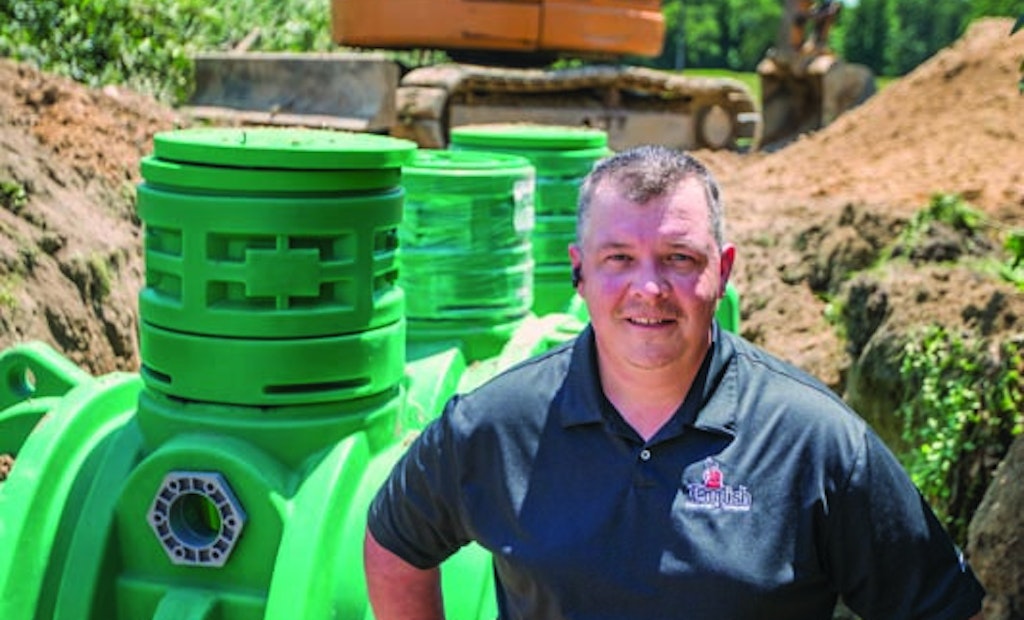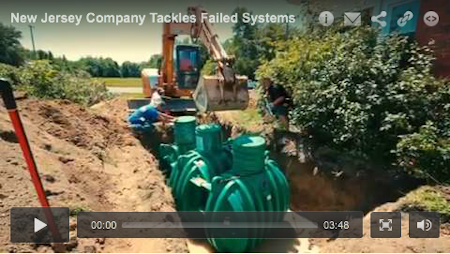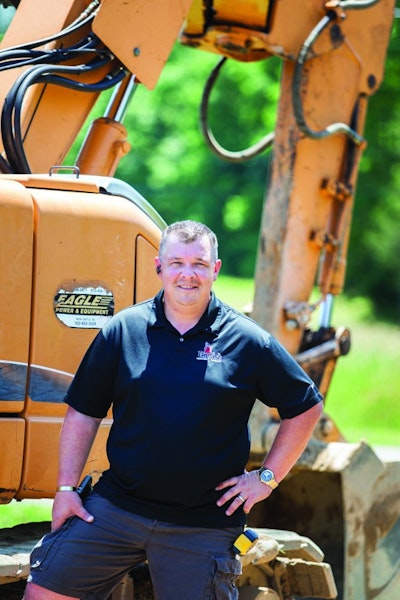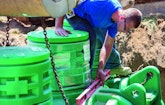
Interested in Excavating?
Get Excavating articles, news and videos right in your inbox! Sign up now.
Excavating + Get AlertsPhone directories, restaurant placemats, billboards and mailers no longer get the promotion job done for English Sewage Disposal in Bridgeton, N.J.
The company still uses those tools but increasingly reaches out to online oriented prospects through a sophisticated website and a large and growing presence on social media. “We know that younger people, especially those just buying homes, don’t know a lot about septic systems,” says Joe Garner, vice president and project manager.
“We’re not going to capture them with a phone book ad or a placemat ad. They’re going to use their smartphone. They’re going to do something digitally. Even the older generations are getting involved with smartphones and tablets. We want to talk to everybody, and the only way to accomplish that is to do traditional as well as social media marketing.”
It’s a formula that works well for promoting diverse onsite services, including the full project management offering that clearly differentiates the company in its market area covering all of south New Jersey, from Trenton east and south. “We manage the engineering process all the way through an approved design,” says Garner. “We also project manage the construction of the system, from the beginning through the final inspection by the local health department, along with frequent post-installation checks.”
GREATLY EXPANDED
English Sewage Disposal began in 1970 as a septic system pumping and portable restroom company; Paul Behrens, an environmental consulting professional, bought it in 1998. He expanded both sides of the business and then moved into septic system repairs and drain cleaning. The project management specialty began when Garner came aboard in 2007.
Today, 90 percent of the business is onsite system installation and related work; the balance includes tank pumping, restroom rental and septic system inspection for real estate transfers. “We take everything one step further,” says Garner. “If an inspection uncovers minor discrepancies, we are able to do those fixes. If we come across a cesspool or an unsatisfactory system, we can project manage the replacement, from design through construction and landscaping.”
English installs 150 to 200 onsite systems per year with three full-time crews and one part-time crew. The company has installed only about two dozen aerobic treatment units (ATUs), but those systems are becoming more common under a new state code introduced in April 2012 – it allows ATUs as long as they have NSF certification. English is a distributor for and installs and maintains Singulair and Singulair Green units from Norweco. The company has also installed and maintains MicroFAST systems from Bio-Microbics and maintains ATUs installed by others. Most drainfields are stone-and-pipe, and septic tanks are mainly precast concrete, although plastic tanks (Infiltrator Systems) sometimes come into play.
The installation equipment fleet includes a 2005 John Deere 160C LC excavator, 1995 Case 9020B excavator, 2005 Case 590 AM II backhoe, 2004 JCB 214 4x4 backhoe, 1997 Komatsu D31 track loader, 2003 Freightliner SL80 tri-axle dump truck and 1988 Ford L9000 dump truck.
CHALLENGING GEOLOGY
In south Jersey, 60 to 70 percent of homeowners have onsite systems. Soils vary greatly. “Soil scientists tell me that when the glaciers came through from the Great Lakes, they did a good job of depositing a lot of junk here,” Garner says. “We run the gamut from very sandy soils with high water tables, to relatively decent soils, to very heavy clay. Right down the street from where we have good sandy soils with a relatively good water table, we can encounter the worst clay you can possibly imagine.
“That makes site evaluations challenging, and that’s why we hire well-qualified soil scientists to assist us. Profile pits allow them to look at the soil horizons and check for seasonally high water tables. They also take samples back to their office and do sieve analyses.” Some soil conditions require 12- to 14-foot-deep excavations followed by replacement with select K4 certified fill.
For onsites with questionable soils and a relatively high water table, an ATU can be more economical than a conventional system. “Under the New Jersey code, the use of an ATU enables us to reduce the size of the drainfield by 20 or 25 percent,” says Garner. “It also gives us the ability to potentially reduce a mound height by 2 to 4 feet and potentially eliminate a dosing tank. Both save money for the customer.
“Suppose we’re at a job site that requires a 2- to 3-foot mound because of a seasonally high water table. If it’s a three-bedroom home, they start out with an 810-square-foot drainfield and a pump station. If we introduce an ATU, sometimes we can get that mound down to ground level, eliminating the pump station, and we can reduce the drainfield to maybe 650 square feet. Under those conditions, we’re almost always able to be price-competitive with an ATU. Where an ATU would be most cost-efficient to install, I work up figures for both a conventional system and an ATU, have a discussion with the customer and go over the pros and cons of both.”
START TO FINISH
Many of the company’s installation projects begin with real estate inspections or routine maintenance visits that turn up issues with an existing system. The first step of project management is engineering. “We bundle everything together so it’s convenient and a little bit cheaper for the customer,” Garner says.
That bundle includes the engineering design, the backhoe to dig the profile pit, the site markout, schedule coordination, interaction with the county health department and all permit fees. The company contracts for engineering services but oversees the entire process. “We witness every profile pit, pull records from the health department and verify the number of bedrooms with the tax assessor’s office,” says Garner. “We compile complete information so that every question is answered. The engineers let us know when the design is ready. We pick it up, attach a check to the package and hand-deliver that to the health department so they can approve it.”
Construction is a second bundle that includes tree removal, plumbing and electrical work as needed, all system components and their installation, coordination of health department inspections, and final landscaping (though some customers do that themselves). An important part of the process is a closeout session with the customer.
“One of our priorities is to educate customers on how to take care of a system – what to do and what not to do with it,” says Garner. “Maintenance is critical to extending a system’s life and keeping it working the correct way. It’s less aggravation for customers in the long run if their system lasts longer and they have less to worry about.
“At the end of a project we have a closeout form. We go over what we did during the installation. We go over the maintenance. We’ve developed an operation and maintenance manual that we can give to the customer every time we finish an installation or repair: This is how often to have your tank pumped out. This is how often to check your effluent filter. No garbage disposals. Don’t put any wet wipes or grease down the drain.”
On the maintenance side, the company sends reminders to customers when pumping is due.
English Sewage Disposal owns eight vacuum trucks, model years 1985 to 2001, with tanks from 2,200 to 4,400 gallons, mostly built by Progress Tank. They carry pumps from National Vacuum Equipment, Wittig (Gardner Denver), Masport, Moro USA and Pearson. The fleet also includes a 1987 Kenworth T80 tractor pulling a 7,000-gallon Fruehauf tank trailer.
All vacuum truck drivers are trained to teach customers the basics of system care. “We like our customers to be home so that when we pump a tank, we can show them what’s going on with the system,” says Garner. “Because they may forget what we told them, the next time we’re out there pumping, we go over it again.”
FINDING CUSTOMERS
While repeat work helps sustain the business, growth depends on new customers. Behrens, Garner and Jamie Bitzer, marketing and advertising director (also DOT administrator), handle promotion from a basic blueprint. The program includes direct mail to lists generated from sewerage authority data: “We market where their sewer customers are not,” says Garner.
The company has upgraded its website to be more educational and to enable customers to order and schedule services from mobile devices. “If people see one of our QR codes on a placemat ad, I want them to be able to scan it and go right to our website,” Garner says. English Sewage Disposal began experimenting with social media four years ago and now embraces it fully. Melissa Smith, construction assistant in the office, is also social media coordinator. She uses these sites:
Facebook. The company has a business page and posts regular updates along with generic information about septic systems. “Many real estate agents are on Facebook, and we’re friends with a lot of them,” says Garner. Posts promote a Septic 101 presentation that Garner gives at no cost to real estate agents. Posts also let municipal teams know the company is available to support them.
Pinterest. Before, during and after photos of installations are posted here. “Pinterest tends to attract more women,” says Garner. “Women tend to care about how it’s going to look. They want to see what kind of disruption will take place on their property, and they want to know that everything will be put back in order when we’re done.”
Twitter. This site serves as an extension of Facebook. The company posts news updates, quick-hit tips about system care and links to articles in the trade and general media that help people understand their systems and maintain them effectively. As of last June, the company had nearly 300 Twitter followers.
LinkedIn. Here the company seeks connections with real estate agents and with middle management people in commercial and industrial businesses. “We stay in touch to let them know what’s going on in the industry and that we’re available to support their efforts,” Garner says.
KEEPING THEM HAPPY
Years of aggressive promotion have helped English Sewage Disposal build a customer database of about 17,000. An enthusiastic staff helps keep those customers happy. Besides those mentioned earlier, key team members include Harold “Rich” Hedman, lead inspector and lead field technician; Jamie Wilson, executive assistant and construction and repair coordinator; and Valerie Coslop, administrative assistant and septic inspection coordinator.
“Everybody fills multiple roles,” says Garner. “They’re extremely dedicated to their jobs, their customers and the industry.” Many team members hold certifications from the National Association of Wastewater Technicians and the Pennsylvania Septage Management Association. The company picks up the costs of certification.
Garner serves on the PSMA education and executive committees and is a director for PSMA Region 7, which covers New Jersey. He is NAWT-certified as a system inspector and installer, has an Advanced Inspector certification from PSMA and is listed as an installer on the Pennsylvania Department of Environmental Protection website. In addition, he holds the National Environmental Health Association Certified Installer Onsite Wastewater Treatment Systems Advanced credential.
Garner attends the Water & Wastewater Equipment, Treatment & Transport Show and shares what he learns with the team. “We’re always looking to expand our operation and come up with new ideas,” he says. “We are in-the-box doers but out-of-the-box thinkers. We want to incorporate whatever we can to make our lives easier, make our jobs easier and make our customers happier.”












